
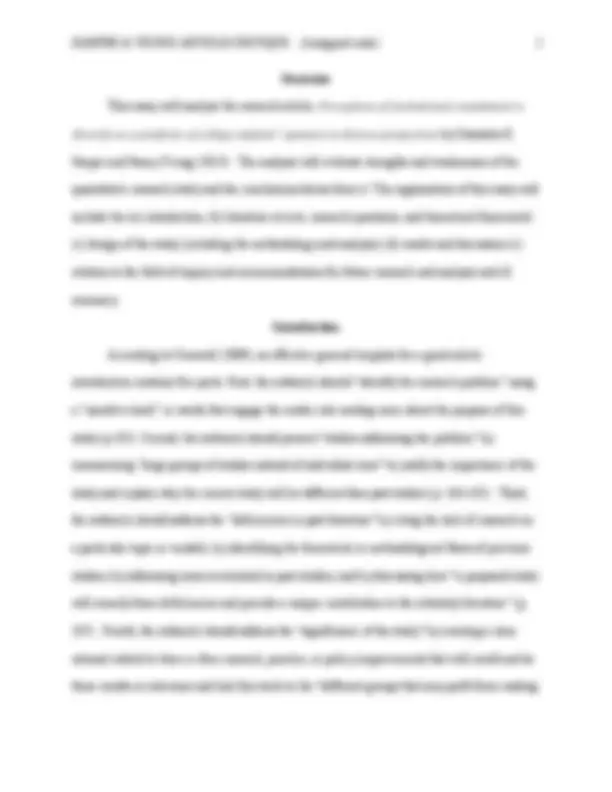
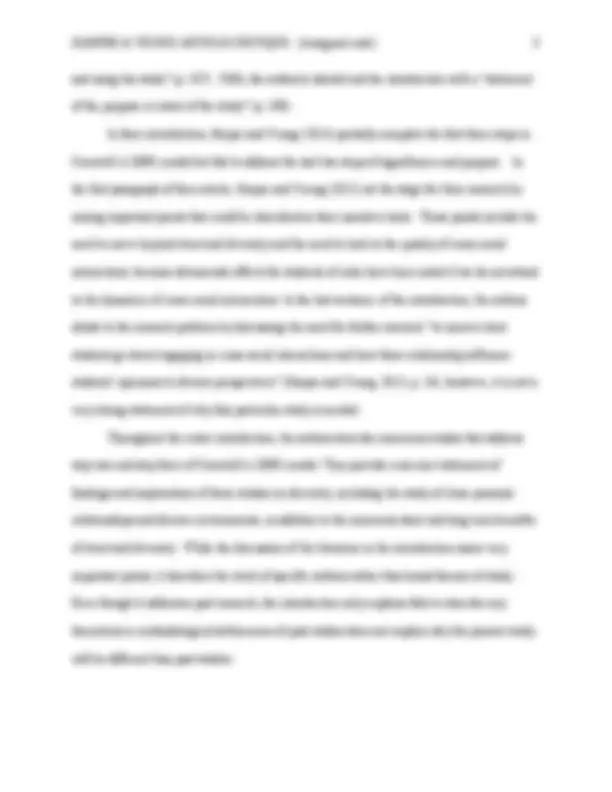
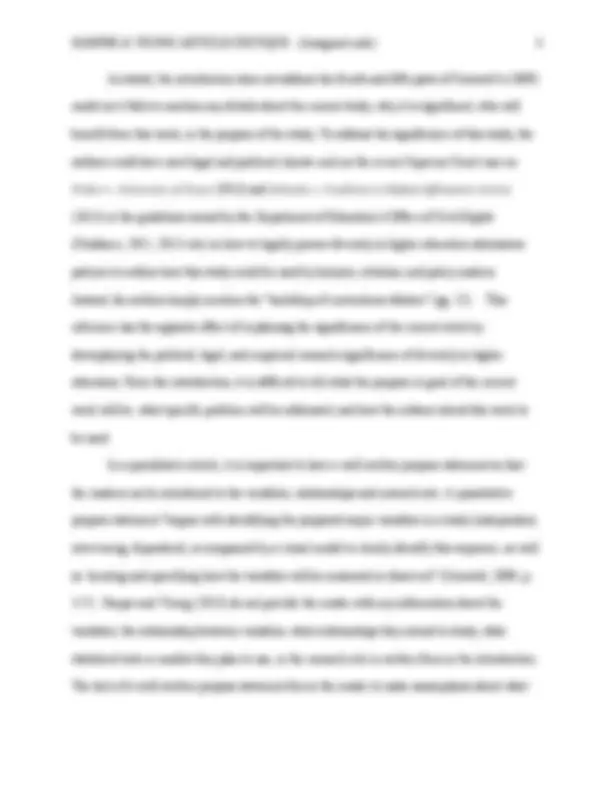
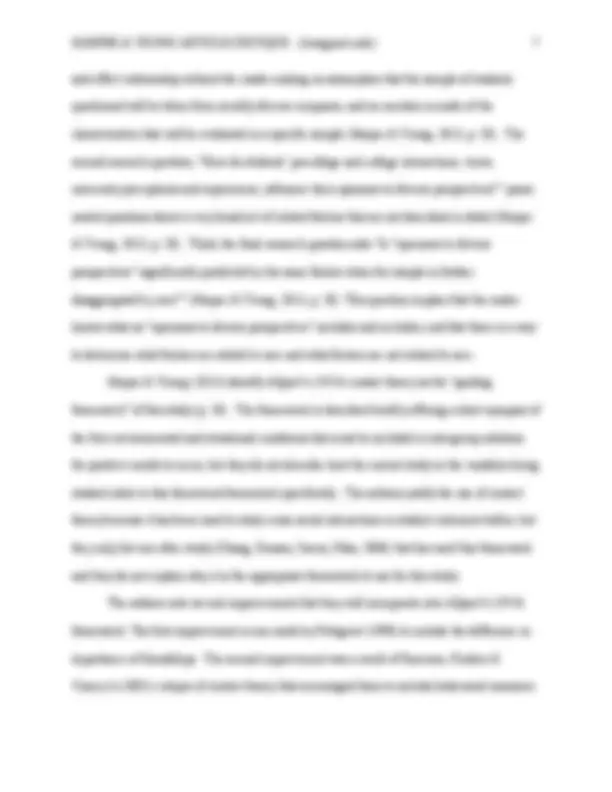
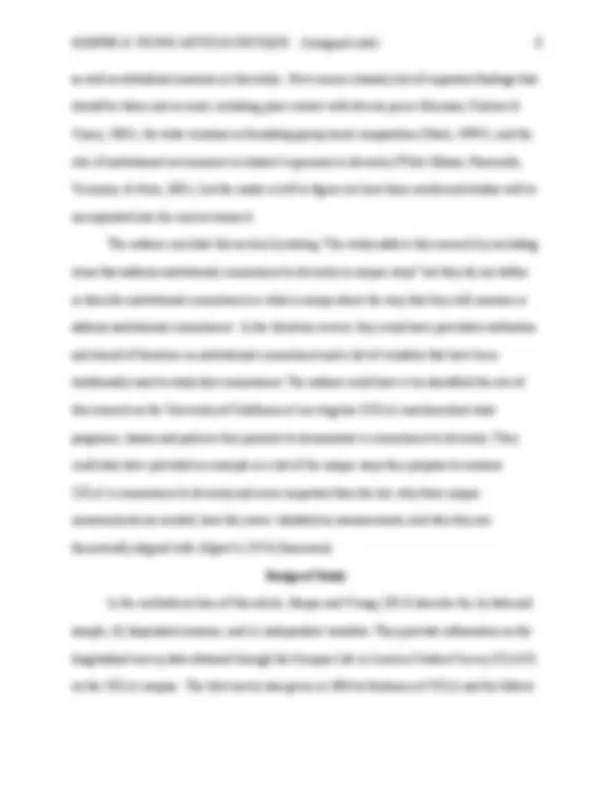
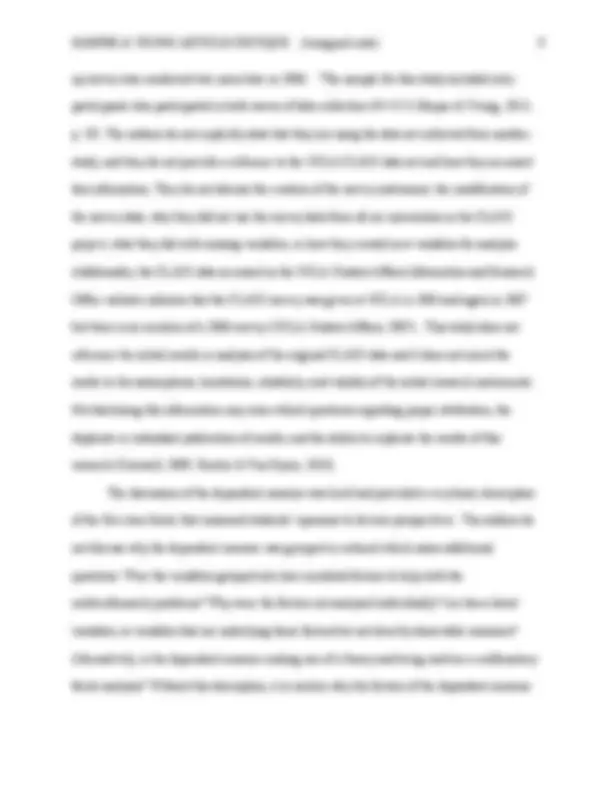
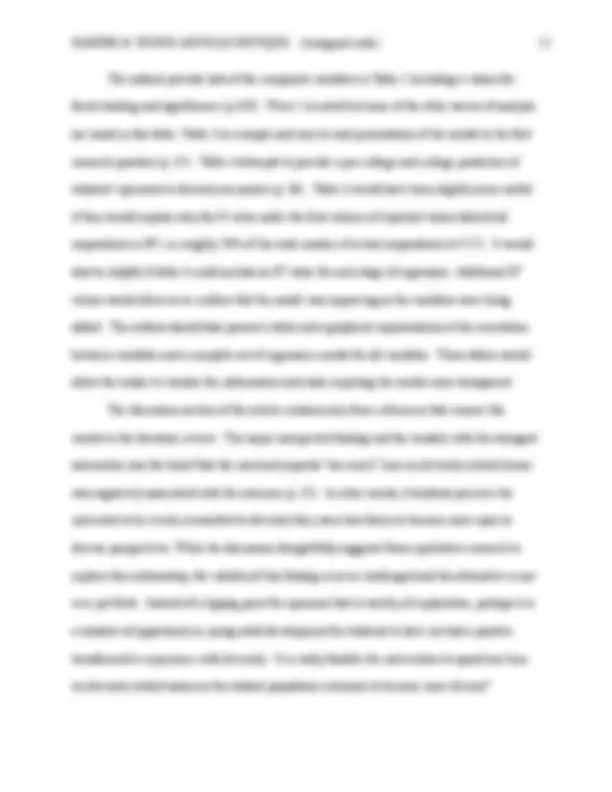
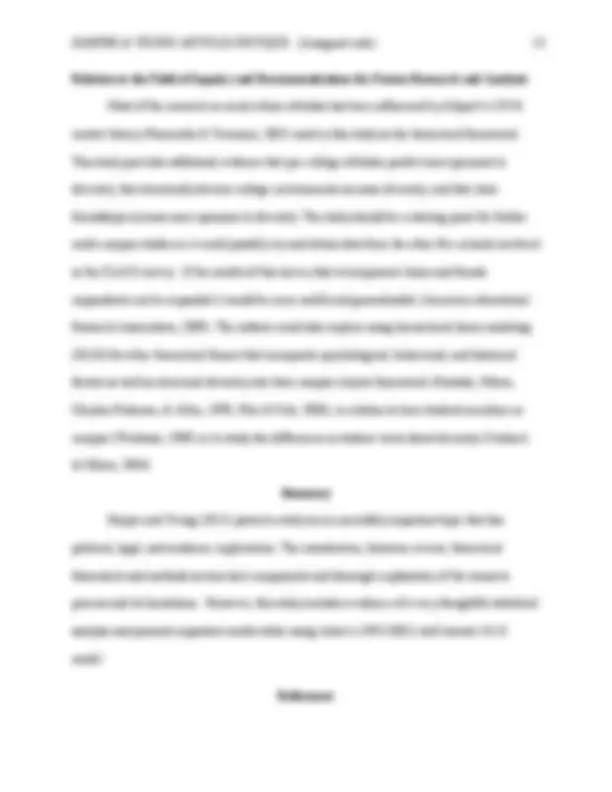
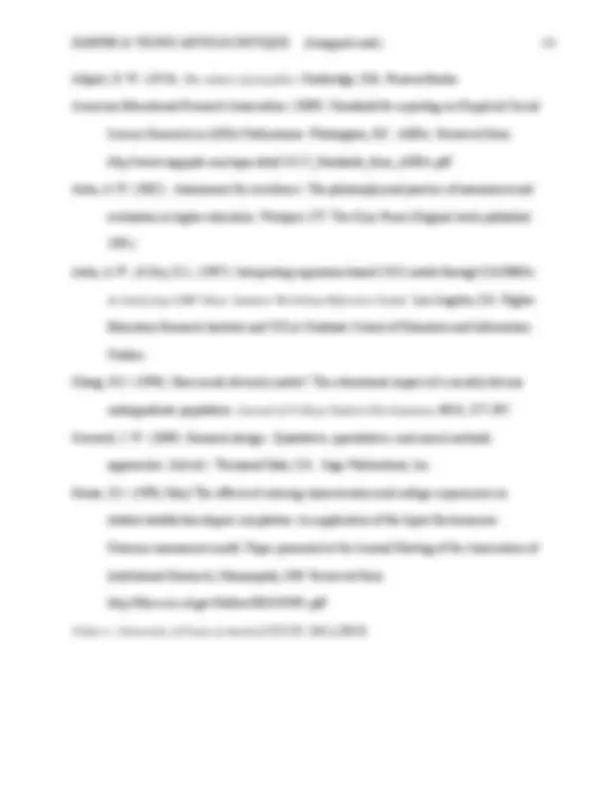


Study with the several resources on Docsity

Earn points by helping other students or get them with a premium plan


Prepare for your exams
Study with the several resources on Docsity

Earn points to download
Earn points by helping other students or get them with a premium plan
Community
Ask the community for help and clear up your study doubts
Discover the best universities in your country according to Docsity users
Free resources
Download our free guides on studying techniques, anxiety management strategies, and thesis advice from Docsity tutors
quantitative research study and the conclusions drawn from it. The organization of this essay will include the (a) introduction, (b) literature review, research ...
Typology: Study notes
1 / 17

This page cannot be seen from the preview
Don't miss anything!










A critique of Harper & Yeung’s Perceptions of institutional commitment to diversity as a predictor of college students’ openness to diverse perspectives.
HALE Comprehensive Exam:Part One, Section B (Assigned code)
HALE Comprehensive Exam Spring 2014 Part One, Section B
Choose one of the articles named below (both available in pdf versions on the D2L communitypage). Write an essay on the strengths and weaknesses of its research and the conclusions drawn from it, and identify the article’s relation to other work in its area(s) of inquiry. Harper, C. and Yeung, F. (2013). Perceptions of institutional commitment to diversity as a predictor of college students’ openness to diverse perspectives. The Review of Higher Education , 37(1), 25-44.
and using the study” (p. 107). Fifth, the author(s) should end the introduction with a “statement of the purpose or intent of the study” (p. 108). In their introduction, Harper and Yeung (2013) partially complete the first three steps in Creswell’s (2009) model but fail to address the last two steps of significance and purpose. In the first paragraph of their article, Harper and Yeung (2013) set the stage for their research by raising important points that could be described as their narrative hook. These points include the need to move beyond structural diversity and the need to look to the quality of cross-racial interactions, because detrimental effects for students of color have been noted if we do not attend to the dynamics of cross-racial interactions. In the last sentence of the introduction, the authors allude to the research problem by discussing the need for further research “to uncover how students go about engaging in cross-racial interactions and how these relationship influence students’ openness to diverse perspectives” (Harper and Yeung, 2013, p. 26), however, it is not a very strong statement of why this particular study is needed. Throughout the entire introduction, the authors describe numerous studies that address step two and step three of Creswell’s (2009) model. They provide a succinct statement of findings and implications of these studies on diversity, including the study of close personal relationships and diverse environments, in addition to the numerous short and long term benefits of structural diversity. While the discussion of the literature in the introduction raises very important points, it describes the work of specific authors rather than broad themes of study. Even though it addresses past research, the introduction only explains fails to describe any theoretical or methodological deficiencies of past studies does not explain why the present study will be different than past studies.
As stated, the introduction does not address the fourth and fifth parts of Creswell’s (2009) model as it fails to mention any details about the current study, why it is significant, who will benefit from this work, or the purpose of the study. To address the significance of this study, the authors could have used legal and political climate such as the recent Supreme Court case on Fisher v. University of Texas (2013) and Schuette v. Coalition to Defend Affirmative Action (2013) or the guidelines issued by the Department of Education’s Office of Civil Rights (Guidance, 2011, 2013 cite) on how to legally pursue diversity in higher education admissions policies to outline how this study could be used by lawyers, scholars, and policy makers. Instead, the authors simply mention the “backdrop of contentious debates” (pg. 25). This reference has the opposite effect of explaining the significance of the current work by downplaying the political, legal, and empirical research significance of diversity in higher education. From the introduction, it is difficult to tell what the purpose or goal of the current work will be, what specific problem will be addressed, and how the authors intend this work to be used. In a quantitative article, it is important to have a well written purpose statement so that the readers can be introduced to the variables, relationships and research site. A quantitative purpose statement “begins with identifying the proposed major variables in a study (independent, intervening, dependent), accompanied by a visual model to clearly identify this sequence, as well as locating and specifying how the variables will be measured or observed” (Creswell, 2009, p. 117). Harper and Yeung (2013) do not provide the reader with any information about the variables, the relationship between variables, what relationships they intend to study, what statistical tests or models they plan to use, or the research site in written form in the introduction. The lack of a well written purpose statement forces the reader to make assumptions about what
indicate that this study employs a survey or that these variables will or will not be used in the present study. The literature review does not address important elements of structural diversity. Research shows that campuses with a high degree of structural diversity can report conflict between the majority and minority racial/ethnic groups without the presence of student-centered support programs that maximize cross-racial interaction and discussion (Chang, 1996; Hurtado, 1992; Hurtado, Carter, & Spuler, 1996). Another weakness of the literature review and of the research proposed by this article is the failure to address other factors that impact campus climate in addition to structural diversity such as the ones proposed by Hurtado, Milem, Clayton- Pederson and Allen (1998) including: (a) the institutional context and their historical legacy of inclusion or exclusion; (b) the psychological dimension of campus climate including individuals’ and group perceptions of discrimination and racial conflict and the institutional response to discrimination; and (c) the behavior dimension of campus climate. Harper and Yeung (2013) later mention the work of Whitt, Edison, Pascarella, Terenzini, and Nora (2001) “as past research examining the environmental influence of institutions and its association with students’ openness to diversity” in the theoretical framework section of the article but, the elements or components of the institutional environment responsible for the attitudes and behaviors are not clarified or discussed. The literature review in this article most closely resembles a systematic literature review. A systematic literature review “typically focuses on a specific empirical question often posed in cause-and-effect form” (Kennedy, 2007, P. 139). At the end of the literature review, three research questions are presented that loosely reflect the elements of the literature provided. The first question, “How racially diverse are students friendship groups?” does not imply a cause-
and-effect relationship without the reader making an assumption that the sample of students questioned will be taken from racially diverse campuses, and no mention is made of the characteristics that will be evaluated in a specific sample (Harper & Yeung, 2013, p. 28). The second research question, “How do students’ precollege and college interactions, views, university perceptions and experiences, influence their openness to diverse perspectives?” poses nested questions about a very broad set of related factors that are not described in detail (Harper & Yeung, 2013, p. 28). Third, the final research question asks “Is “openness to diverse perspectives” significantly predicted by the same factors when the sample is further disaggregated by race?” (Harper & Yeung, 2013, p. 28). This question implies that the reader knows what an “openness to diverse perspectives” includes and excludes, and that there is a way to determine what factors are related to race and what factors are not related to race. Harper & Yeung (2013) identify Allport’s (1954) contact theory as the “guiding framework” of this study (p. 28). The framework is described briefly offering a short synopsis of the four environmental and situational conditions that must be included in intergroup relations for positive results to occur, but they do not describe how the current study or the variables being studied relate to this theoretical framework specifically. The authors justify the use of contact theory because it has been used to study cross-racial interactions in student outcomes before, but they only list one other study (Chang, Denson, Saenz, Misa, 2006) that has used this framework and they do not explain why it is the appropriate framework to use for this study. The authors note several improvements that they will incorporate into Allport’s (1954) framework. The first improvement is one made by Pettigrew (1998) to include the difference in importance of friendships. The second improvement was a result of Emerson, Kimbro & Yancey’s (2002) critique of contact theory that encouraged them to include behavioral measures
up survey was conducted two years later in 2006. “The sample for this study included only participants who participated in both waves of data collection (N=517) (Harper & Yeung, 2013, p. 29). The authors do not explicitly state that they are using the data set collected from another study, and they do not provide a reference to the UCLA CLASS data set and how they accessed this information. They do not discuss the creation of the survey instrument, the modification of the survey data, why they did not use the survey data from all six universities in the CLASS project, what they did with missing variables, or how they created new variables for analysis. Additionally, the CLASS data accessed on the UCLA Student Affairs Information and Research Office website indicates that the CLASS survey was given at UCLA in 2004 and again in 2007 but there is no mention of a 2006 survey (UCLA Student Affairs, 2007). This study does not reference the initial results or analysis of the original CLASS data and it does not orient the reader to the assumptions, limitations, reliability, and validity of the initial research instruments. Not disclosing this information may raise ethical questions regarding proper attribution, the duplicate or redundant publication of results, and the ability to replicate the results of this research (Creswell, 2009, Remler & Van Ryzin, 2010). The discussion of the dependent measure was brief and provided a very basic description of the five-item factor that measured students’ openness to diverse perspectives. The authors do not discuss why the dependent measure was grouped or reduced which raises additional questions: Were the variables grouped into less correlated factors to help with the multicollinearity problems? Why were the factors not analyzed individually? Are there latent variables, or variables that are underlying these factors but not directly observable measures? Alternatively, is the dependent measure making use of a theory and being used as a confirmatory factor analysis? Without this description, it is unclear why the factors of the dependent measure
are being combined and what assumptions or limitations are being presented (Remler & Van Ryzin, 2010). The independent variables are presented in thematic grouping and several explanations were provided for specific terms and variables. However, this section also did not explain all of the included variables, how or why they were included in the regression model and if any variables from the original study were excluded or reduced into multifactor variables. Harper and Yeung (2013) did discuss the benefits of a longitudinal data set and noted that they could control for the students’ precollege experiences including racial/ethnic diversity of their high school, the amount of racial/ethnic interaction in high school, and students’ precollege openness to diverse peers and perspectives (p. 32). The authors do not tell the reader how they controlled for these factors. Harper and Yeung (2013) explain that they first analyzed descriptive statistics and that then used ordinary least squares (OLS) regression analysis. They justify the use of OLS because it has been recently used by Mayhew, Grunwald, and Dey (2006) but do not explain why it is the proper statistical analysis, what other options were considered and what the benefits and drawbacks were for conducting this analysis. They further describe using a blocked hierarchical approach to add variables to the model and tie this to Astin’s (1991/2002) Input-Environment- Outcomes (I-E-O) model. Both of these techniques are very specific and the Astin and Dey (2006) resource that is referenced for this method was unable to be located for review but it has been referenced as an unpublished manuscript in other publications (Tanaka, 2007). Astin and Dey (1997) have provided instruction on Causal Analytical Modeling via Blocked Regression Analysis (CAMBRA) procedures to evaluate I-E-O results at UCLA during a summer workshop but that reference guide is not referenced here (House, 1998). Harper and Yeung (2013) could
The authors provide lists of the composite variables in Table 2 including a values for factor loading and significance (p.310). Wave 2 is noted but none of the other waves of analysis are noted in this table. Table 3 is a simple and easy to read presentation of the results to the first research question (p. 35). Table 4 attempts to provide a pre-college and college predictors of students’ openness to diversity as juniors (p. 36). Table 4 would have been slightly more useful if they would explain why the N value under the first column of reported values labeled all respondents is 397, or roughly 76% of the total number of actual respondents (n=517). It would also be helpful if table 4 could include an R^2 value for each stage of regression. Additional R^2 values would allow us to confirm that the model was improving as the variables were being added. The authors should also present a table and a graphical representation at the correlation between variables and a complete set of regression results for all variables. These tables would allow the reader to visulize the information and make reporting the results more transparent. The discussion section of the article contains only three references that connect the results to the literature review. The major unexpected finding and the variable with the strongest association was the belief that the university spends “too much” time on diversity-related issues was negatively associated with the outcome (p. 37). In other words, if students perceive the university to be overly committed to diversity they were less likely to become more open to diverse perspectives. While the discussion thoughtfully suggests future qualitative research to explore this relationship, the validity of this finding is never challenged and the alternative is not ever put forth. Instead of a tipping point for openness that is worthy of exploration, perhaps it is a window of opportunity in young adult development for students to have not had a positive transformative experience with diversity. It is really feasible for universities to spend less time on diversity related issues as the student population continues to become more diverse?
Relation to the Field of Inquiry and Recommendations for Future Research and Analysis Most of the research on racial-ethnic attitudes has been influenced by Allport’s (1954) contact theory (Pascarella & Terenzini, 2005) used in this study as the theoretical framework. This study provides additional evidence that pre-college attitudes predict ones openness to diversity, that structurally diverse college environments increase diversity, and that close friendships increase ones openness to diversity. The study should be a starting point for further multi-campus studies or it could possibly try and obtain data from the other five schools involved in the CLASS survey. If the results of this survey that overrepresent Asian and female respondents can be expanded it would be more useful and generalizable (American educational Research Association, 2009). The authors could also explore using hierarchical linear modeling (HLM) for other theoretical frames that incorporate psychological, behavioral, and historical factors as well as structural diversity into their campus climate framework (Hurtado, Milem, Clayton-Pedersen, & Allen, 1998; Pike & Kuh, 2006), in relation to how students socialize on campus (Weidman, 1989) or to study the differences in student views about diversity (Umbach & Milem, 2004). Summary Harper and Yeung (2013) present a study on an incredibly important topic that has political, legal, and academic implications. The introduction, literature review, theoretical framework and methods section lack components and thorough explanation of the research process and its limitations. However, this study includes evidence of a very thoughtful statistical analysis and presents important results while using Astin’s (1991/2002) well known I-E-O model.
References
Running head: HARPER & YEUNG ARTICLE CRITIQUE (Assigned code) 15
Guidance on the voluntary use of race to achieve diversity in postsecondary education. (2013) Office for Civil Rights, U.S. Department of Education. Retrieved from http://www2.ed.gov/about/offices/list/ocr/docs/guidance-pse-201111.html Harper, C. and Yeung F. (2013). Perceptions of institutional commitment to diversity as a predictor of college students’ openness to diverse perspectives. The Review of Higher Education , 37(1), 25-44. Hurtado, S. (1992). The campus racial climate: Contexts for conflict. The Journal of Higher Education, 63(5), 539-569. Hurtado, S., Carter, D.F., & Spuler, A. (1996). Latino student transition to college. Research in Higher Education, 37 (2), 135-157. Hurtado, S., Milem, J.F., Clayton-Pedersen, A.R., and Allen, W.R. (1998). Enhancing campus climates for racial/ethnic diversity: Educational policy and practice. The Review of Higher Education , 21, 279-302. Kennedy, M. M. (2007). Defining a literature review. Education Researcher , 36(3), 139-147. Mayhew, M. J., Grunwald, H. E., & Dey, E. L. (2006). Breaking the silence: Achieving a positive campus climate for diversity from the staff perspective. Research in Higher Education, 47, 63 – 88. Pascarella, E., & Terenzini,P. (2005) How College Affects Students. San Francisco, CA: Jossey- Bass. Pike, G.R., & Kuk, G.D. (2006) Relationships among structural diversity, informal peer interactions and perceptions of the campus enviornment. The Review of Higher Education. 29(4). 425-450.
Remler, D. & Van Ryzin, G. (2010). Research Methods in Practice: Strategies for Description and Causation. Thousand Oaks, CA: Sage Publications. Schuette v. Coalition to Defend Affirmative Action , 133 S. Ct. 1633 (2013) Tanaka, G. (2007). The intercultural campus: Transcending culture and power in American higher education. New York, NY: Peter Lang Publishing. UCLA Student Affairs Information and Research Office (SAIRO). (2007). CLASS Project Wave 2 Questionnaire – UCLA. Retrieved from: http://www.sairo.ucla.edu/data/efforts_campus.html Umbach, P.D., & Milem, J.F. (2004) Applying Holland’s typology to the study of differences in student views about diversity. Research in Higher Education. 45(6) 625-649. Weidman, J. C. (1989). Undergraduate socialization: A conceptual approach. In J. C. Smart (Ed.), Higher Education: Handbook of Theory and Research , 5 , 289 – 322. New York, NY: Agathon. Whitt, E. J., Edison, M. I., Pascarella, E. T., Terenzini, P. T., & Nora, A. (2001). Influences on students’ openness to diversity and challenge in the second and third years of college. Journal of Higher Education, 72 (2), 172–204.